
The common blackbird is a species of true thrush. It is also called the Eurasian blackbird, or simply the blackbird where this does not lead to confusion with a similar-looking local species. It breeds in Europe, Asiatic Russia, and North Africa, and has been introduced to Australia and New Zealand. It has a number of subspecies across its large range; a few of the Asian subspecies are sometimes considered to be full species. Depending on latitude, the common blackbird may be resident, partially migratory, or fully migratory.

Icterids or New World blackbirds make up a family, the Icteridae, of small to medium-sized, often colorful, New World passerine birds. The family contains 108 species and is divided into 30 genera. Most species have black as a predominant plumage color, often enlivened by yellow, orange, or red. The species in the family vary widely in size, shape, behavior, and coloration. The name, meaning "jaundiced ones" comes from the Ancient Greek ikteros via the Latin ictericus. This group includes the New World blackbirds, New World orioles, the bobolink, meadowlarks, grackles, cowbirds, oropendolas, and caciques.

The yellow-headed blackbird is a medium-sized blackbird with a yellow head.
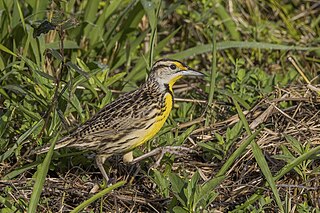
The eastern meadowlark is a medium-sized blackbird, very similar in appearance to sister species western meadowlark. It occurs from eastern North America to northern South America, where it is also most widespread in the east. The Chihuahuan meadowlark was formerly considered to be conspecific with the eastern meadowlark.

Bullock's oriole is a small New World blackbird. At one time, this species and the Baltimore oriole were considered to be a single species, the northern oriole. This bird is named after William Bullock, an English amateur naturalist.
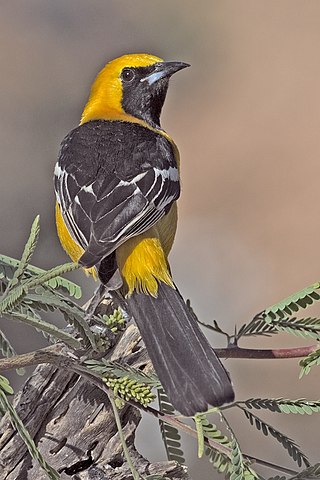
The hooded oriole is a medium-sized New World oriole. The male of this species ranges in color from a bright orange to a paler yellow, with a black back, face, tail and bib, with the wing containing two white bars. The female is more of an olive color with some yellow accents.
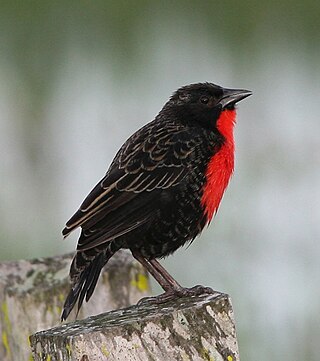
The red-breasted meadowlark is a passerine bird in the New World family Icteridae. It was formerly named red-breasted blackbird but is not closely related to the red-winged blackbird group.

The giant cowbird is a large passerine bird in the New World family Icteridae. It breeds from southern Mexico south to northern Argentina, and on Trinidad and Tobago. It may have relatively recently colonised the latter island. It is a brood parasite and lays its eggs in the nests of other birds.

The white-browed meadowlark is a passerine bird in the New World family Icteridae. It was formerly named white-browed blackbird but is not closely related to the red-winged blackbird group.

Oropendolas are a genus of passerine birds, Psarocolius, in the New World blackbird family Icteridae. They were formerly split among two or three different genera and are found in Central and South America.

The caciques are passerine birds in the New World blackbird family which are resident breeders in tropical South America north to Mexico. All of the group are in currently placed in the genus Cacicus, except the aberrant yellow-billed cacique, and the Mexican cacique which constitute respective monotypic genera. Judging from mitochondrial DNA cytochrome b and NADH dehydrogenase subunit 2 sequence, the aberrant oropendolas band-tailed oropendola and casqued oropendola, Psarocolius oseryi seem to be closer to the caciques.
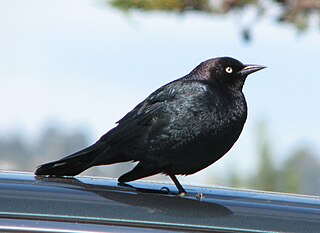
Euphagus is a small genus of American blackbirds. It contains two extant species: Brewer's blackbird, Euphagus cyanocephalus, and rusty blackbird E. carolinus.

The scarlet-rumped cacique is a passerine bird species in the New World family Icteridae. It breeds from eastern Honduras to Panama and in the Pacific lowlands of South America from western Colombia south to Ecuador, and in the lower reaches of the northern Andes. There are several subspecies, some of which have been proposed for elevation to full species status.

Audubon's oriole, formerly known as the black-headed oriole, is a New World passerine inhabiting the forests and thickets of southeastern Texas and the Mexican coast. It is the only species to have a black hood and yellow body. It is divided into four subspecies and two allopatric breeding ranges. The westernmost range extends from Nayarit south to southern Oaxaca, whereas the eastern range stretches from the lower Rio Grande valley to northern Querétaro. The most common in the western range are the subspecies I. g. dickeyae and I. g. nayaritensis; I. g. graduacauda and I. g. audubonii can be found in the eastern range. Like most Central American birds, it is not a migratory species and does not display significant sexual dimorphism. DNA analysis of the ND2 and cyt-b genes strongly suggests that I. graduacauda is most closely related to I. chrysater, the yellow-backed oriole. It is a member of the genus Icterus and therefore should not be confused with the Old World orioles.

The yellow-backed oriole is a species of bird in the family Icteridae.

The Saint Lucia oriole is a species of bird, in the family Icteridae and genus Icterus. It is endemic to Saint Lucia.
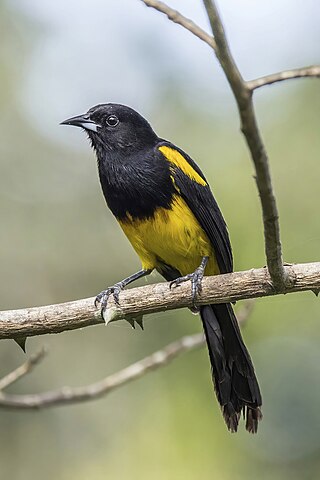
The black-cowled oriole is a species of bird in the family Icteridae. It is common and widespread in the Caribbean lowlands and foothills from southern Mexico to western Panama. It lives primarily in humid or semihumid forest, as well as in clearings, along forest edges, in plantations, in semi-open areas with scattered trees and bushes, and in gardens. The adult male is black, with yellow on the belly, shoulder, rump, wing lining, and crissum. The female's plumage varies depending on location. In the south of its range, it is similar to that of the male. In the north, its crown and upperparts are olive-yellow, while its face, throat, upper breast, wings, and tail are black.

The Jamaican blackbird is a species of bird in the New World blackbird and oriole family Icteridae. It is the only species (monotypic) in the genus Nesopsar. The species has sometimes been included in the genus Agelaius, but molecular systematics have shown it not be closely related to any living New World blackbird or grackle. The species is endemic to Jamaica, where it is restricted to Cockpit Country, some central areas and the Blue and John Crow Mountains.

The Nicaraguan grackle is a species of passerine bird belonging to the genus Quiscalus, a genus of grackles in the New World blackbird family, Icteridae. It is found only in Nicaragua and northernmost Costa Rica.
The convex-billed cowbird is an extinct species of bird in the family Icteridae, described in 1947 by Alden H. Miller. It is the only member of its genus, Pandanaris.




















